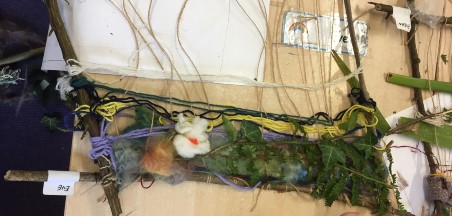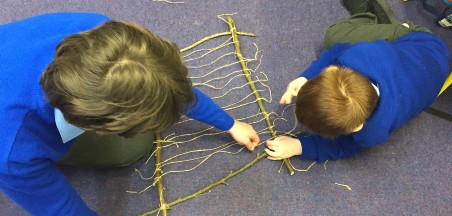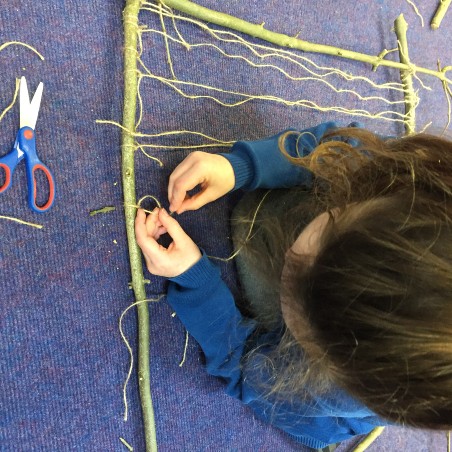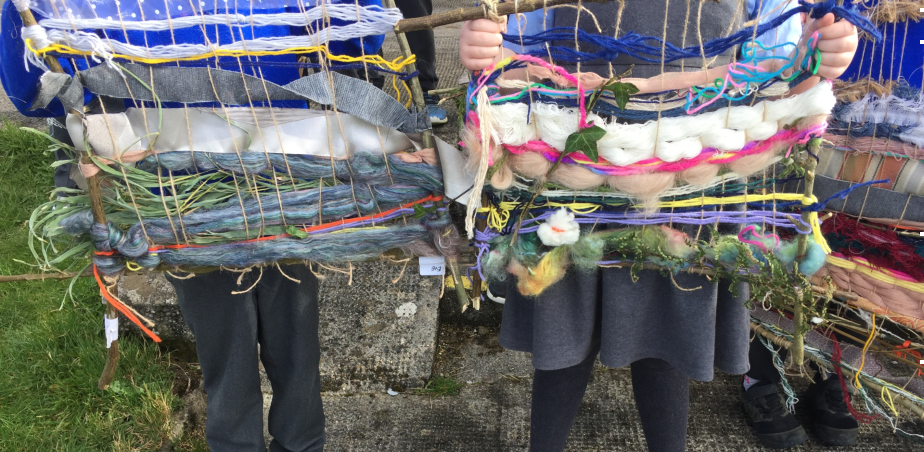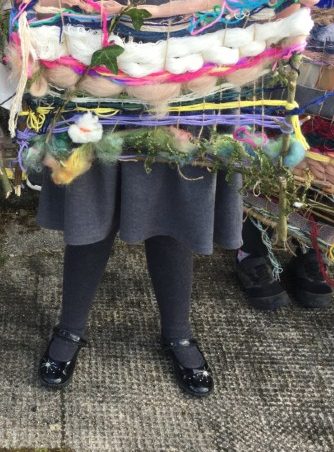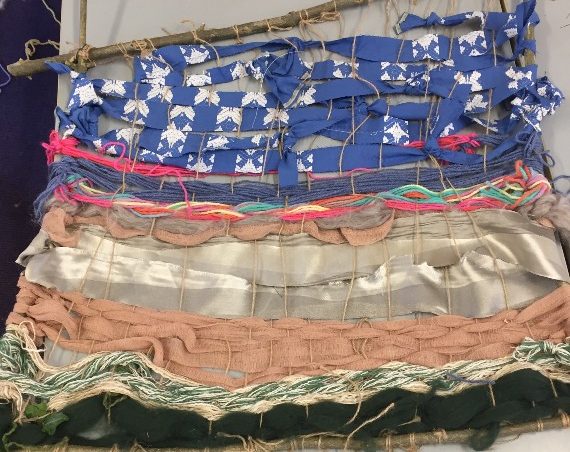Refine by Region
Refine by Art Form
Refine by School Level
Weaving the Walk
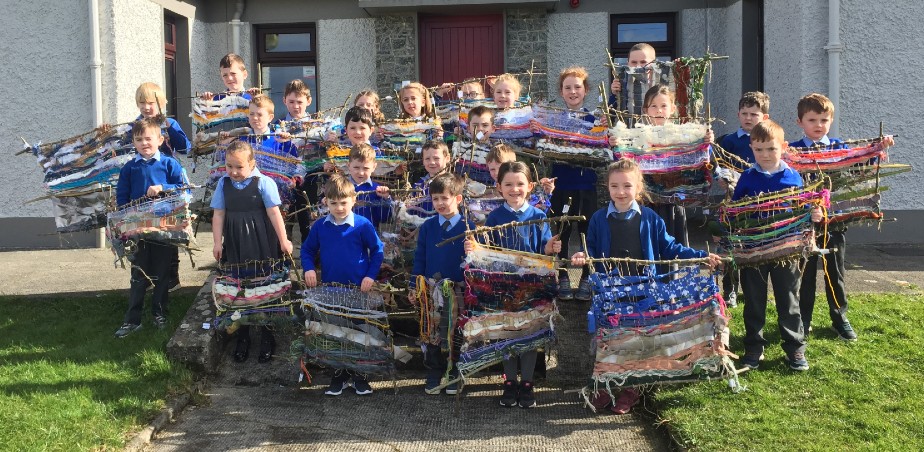
Tell us the story of your project – What was the impetus? What was it about? Who was involved? How did you begin?
Artist Annabel Konig
When discussing the possible project with the teacher of the classes I was going to work with, we discovered that nature, observation, fabrics and the environment, were the main topics that were going to make up the project idea. Based on those, ‘weaving the walk’, was born. The idea was that each child would go for a walk with an adult and look at their surroundings differently, looking at textures, picking up weavable materials, make drawings and if they could, write words, in a notebook which would be their form of reference for the weaving we were going to make.
The frames for the weavings were made from branches that I brought in. Each child had to learn how to tie knots, measure string and create the framework. There was co-operation between the classes as some children were quite young.
Teacher Brenda Binions
I had previously taught the children some simple weaving techniques and am passionate about our local environment, so I was excited to collaborate with Annabel on this topic. We decided on this project very quickly during our first collaboration meeting. Prior to our first workshop, I spoke to the children about the project and they were very enthusiastic. I also sent a note home to the parents, outlining our ideas and asking for their help in taking the children for a walk and gathering suitable materials for our weaving. Unfortunately the weather hadn’t been very nice, so not all children had been for a walk so we took an observational walk around the school grounds and looked at the colours and textures we could see around us.
During the first workshop, Annabel discussed the project with the children. Some of the children had brought in materials for the weaving and we looked at these and discussed their suitability, or otherwise, with the children. When we started putting the frames together, it quickly became obvious that tying strings was too difficult for the younger children so we enlisted the help of the older classes to assist them. This lead to the project becoming a collaboration for the whole school, as, over the course of the project, all 48 children in the school had the opportunity to engage hands on in the project.
How were the ideas developed and how did the young people, artist and teacher work together?
Artist Annabel Konig
The second workshop centered on the brought in materials and drawings that the students had made. The drawings were the layout plan. Each child then made a general weaving plan, based on their own frame – some being horizontal, one vertical some large, etc. Both the school and myself had brought in additional soft, weavable materials, which were interpreted by the students as flowers, sheep, trees, grass and sky. The textures of the materials made the pupils consider what a bush might look like or a stream, a flower, etc.
At the end of the project, each child had a finished, or near to finished piece and could tell the story to someone else of how their walk was converted into a weaving.
Teacher Brenda Binions
Annabel asked the children to draw the story of their walk and then select suitable materials to represent the story. She asked them what they knew about weaving and explained the techniques that would be needed in this project. She explained the importance of tying the woven strands to support the structure of the weaving and discussed which materials might represent the different aspects of their walk. Again, the actual weaving was a challenge for some of the junior children. So we got some of the children in the senior room to help. We also had the assistance of our SNA in the room, which helped greatly. Some of the children found it difficult to get started on selecting materials and others grasped the concept straight away and showed great imagination in representing their walk in the weaving.
After each workshop, I asked the children to reflect on what they had been doing. We discussed it first and then they wrote about it. I put some of these responses in a scrapbook, along with photographs of the various stages, to keep as a record.
When they had finished their pieces of weaving, we took them to the other class to show them how they had turned out and each child told the “story” of their walk, as represented in their weaving.
What was your personal experience of the project in terms of successes and challenges?
Artist Annabel Konig
I always learn from children, the way they interpret ideas, the way they manage to work in materials – often different than I would so I re-discover the possibilities of working. Many of the students discovered that the even though their walks were similar, how they picked the fabrics to represent elements in the landscape, altered how others understood their work. The challenges some of the students found was that in their initial excitement after the project had been explained to them, is that they may have bitten off more than they could chew in the size of their frames. Big is not always better. Successes were many for each individual child, being able to stand up at the end of the process to explain their work, finding that they were good at something event though school work generally is hard for them and, as one little boy said to me ‘I know how to tie my shoelaces now’, shows that, through an art process one can obtain life skills.
Teacher Brenda Binions
I really enjoyed this project and I know the children did too. There were challenges for sure, not least where to store the weaving frames between workshops! We were very lucky in that we had a wide selection of weavable materials, some of which I had in the school but much of it was provided by Annabel . We had initially asked the children to bring in found materials which they could incorporate in their weaving, but much of this was unworkable and in the end, we mostly used fabric strips , wool and twine to represent the landscape. The children focused on colour and texture to represent their walk. We could not have done this project without adult assistance and the assistance of the children in the 3rd, 4th, 5th and 6th classes. However, the children gained great skills in selecting materials, weaving, cutting, tying and describing their work.
What was significant for you about the project that is worth sharing?
Artist Annabel Konig
Process, process, process. You can learn skills that cross over into other elements of life and school subjects. Learning through creativity can often not feel like homework or hard learning, it can be done through fun and ‘outside the box’ approaches.
Teacher Brenda Binions
I always value the chance to collaborate with an artist. In this case, the project stretched the children’s creativity and expanded their skills, not just in art but in awareness of their environment, developing their confidence and collaboration with others. They each had a great sense of achievement and were delighted to show and bring home their finished piece.
Has anything changed in your work as a result of the project?
Artist Annabel Konig
Any workshop I do with children always encourages me to do more and to up the anti. Young people are so much more able than we think, once you give them the skills to succeed.
Teacher Brenda Binions
I think that as a teacher, I am inclined to keep projects small and within the confines of the classroom. This project had inspired me to look beyond the classroom and think outside the box. It has inspired me to ask more of the children and, with help from other adults and older children, encourage the children to expand their creativity.
Spotlight
Artist(s):
Artist Annabel Konig
Interdisciplinary in nature, my practice employs a wide range of media. I’m not tied to any one discipline. In fact, my practice requires me to explore new and combined methods, thus discovering conclusions relevant to the work I wish to explore.
In my work I often collaborate with other artists and with the general public. I look for technical assistance when I need it as my ideas can sometimes be complicated and require expertise I do not have. Yet often, in other work, such as the drawing show “I smile at Life” I have worked on my own, with my own demons.
I have been working with young children and young adults for some 20 years now. I tailor each project according to the students I will be working with, the teacher’s aims and ambitions and the surrounding and abilities in which each group finds themselves. Working with young people is an inspiration to me, time and again.
Teacher(s):
Teacher Brenda Binions
I am a primary school teacher with 35 years experience in the classroom. I have always been interested in the arts and, over the years, have provided many varied opportunities to my pupils to allow them engage with the arts. I have collaborated with many different artists over the years, and have always found it to be a positive experience.
When the opportunity arose to apply for this years CraftEd I was delighted .Our school has been involved with the Creative schools project for the past two years . I have been involved with Craft in the Classroom and have also been part of CraftEd previously , about ten years ago. My current class range between 5 and 9 years of age. Junior infants to Second class.
I have found this to be a very positive creative experience.
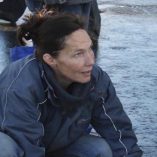
Artist(s)
Annabel Konig

Teacher(s)
Brenda Binions
Artforms
School Level
School/
Participant Group
St. Patrick’s NS, Co. Carlow
No. Participants
25
Region
Age/Class
5 to 8 year olds
Dates
February to March 2020
Leading Agency
CRAFTed
Other Partners and/or Funders
Wexford Education Centre
Key themes/ lines of enquiry
Expressing nature through weaving, incorporating found objects and materials. Drawing what you see and learning to translate into a different material. Learning simple skills such as tying knots. Being able to express what you experienced to a group of your peers.
Curriculum Strands
Textiles and fabrics – art, writing – English, drawing – art, measuring – maths, environmental studies, self confidence – well-being.
I always learn from children, the way they interpret ideas, the way they manage to work in materials – often different than I would so I re-discover the possibilities of working.
Artist Annabel Konig
